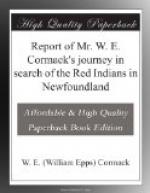Our only and frail hope now left of seeing the Red Indians lay on the banks of the River Exploits, on our return to the sea-coast.
The Red Indians’ Lake discharges itself about three or four miles from its north-east end, and its waters from the River Exploits. From the lake to the sea-coast is considered about seventy miles; and down this noble river the steady perseverance and intrepidity of my Indians carried me on rafts in four days, to accomplish which otherwise, would have required, probably, two weeks. We landed at various places on both banks of the river on our way down, but found no traces of the Red Indians so recent as those seen at the portage at Badger Bay-Great Lake, towards the beginning of our excursion. During our descent, we had to construct new rafts at the different waterfalls. Sometimes we were carried down the rapids at the rate of ten miles an hour or more, with considerable risk of destruction to the whole party, for we were always together on one raft.
What arrests the attention most while gliding down the stream, is the extent of the Indian fences to entrap the deer. They extend from the lake downwards, continuous, on the banks of the river at least thirty miles. There are openings left here and there in them, for the animals to go through and swim across the river, and at these places the Indians are stationed, and kill them in the water with spears, out of their canoes, as at the lake. Here, then, connecting these fences with those on the north-west side of the lake, is at least forty miles of country, easterly and westerly, prepared to intercept all the deer that pass that way in their periodical migrations. It was melancholy to contemplate the gigantic, yet feeble efforts of a whole primitive nation, in their anxiety to provide subsistence, forsaken and going to decay.
There must have been hundreds of the Red Indians, and that not many years ago, to have kept up these fences and ponds. As their numbers were lessened so was their ability to keep them up for the purposes intended; and now the deer pass the whole line unmolested.
We infer, that the few of these people who yet survive, have taken refuge in some sequestered spot, still in the northern part of the island, and where they can procure deer to subsist on.
On the 29th November we were again returned to the mouth of the River Exploits, in thirty days after our departure from thence, after having made a complete circuit of about 200 miles in the Red Indian territory.




